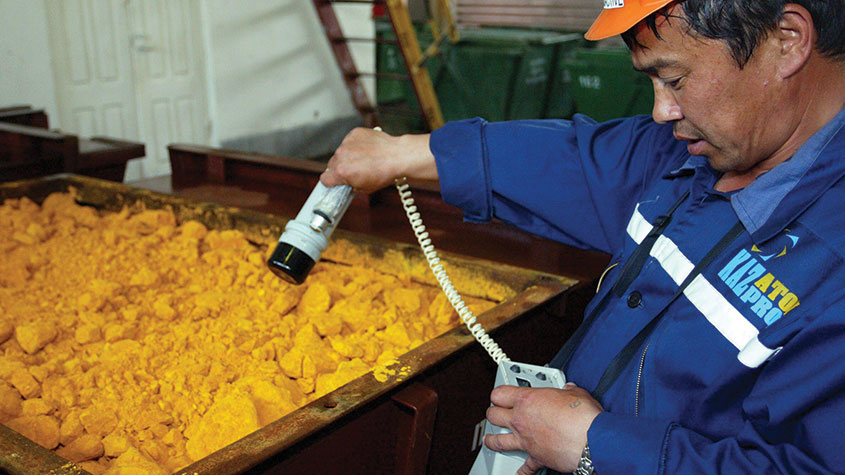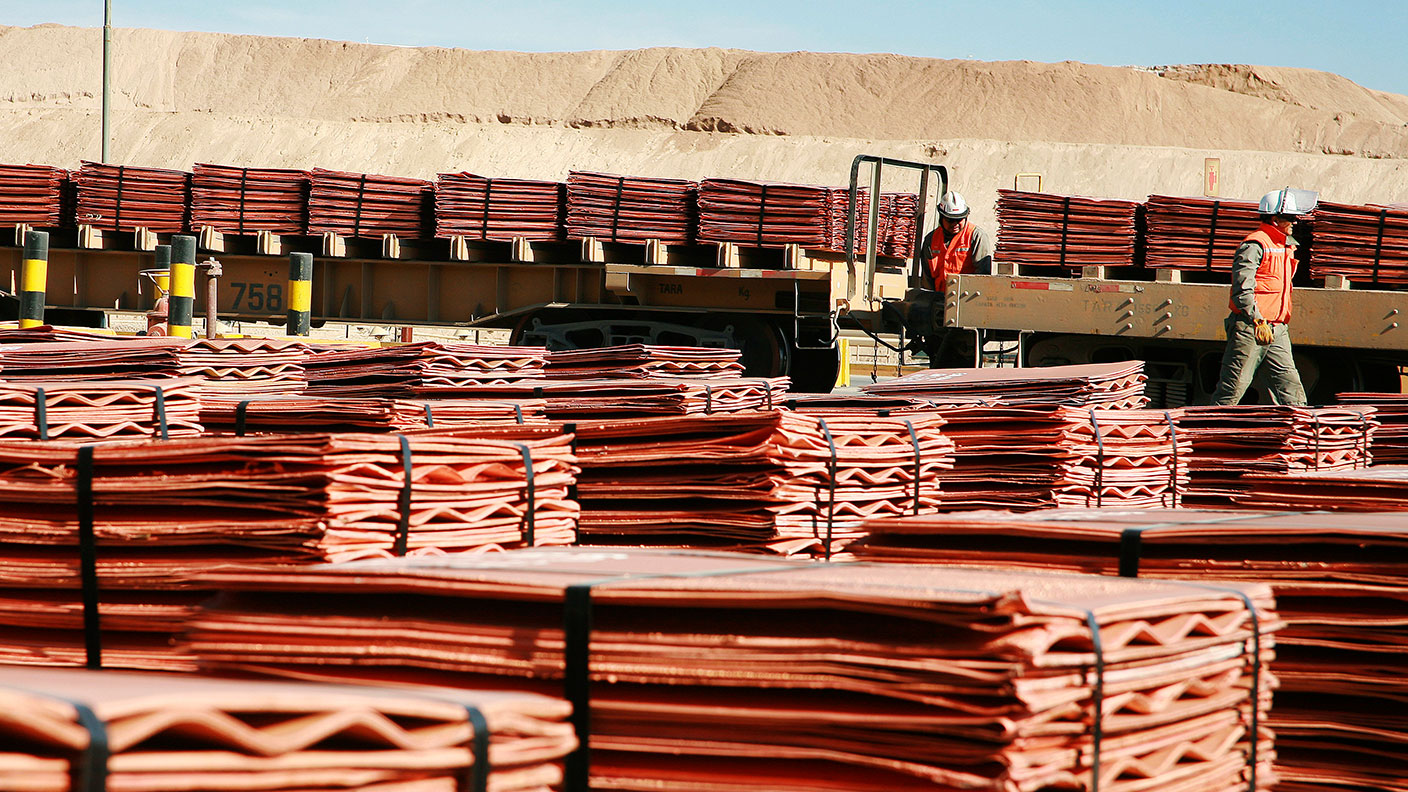8 gold funds to consider for exposure to the yellow metal
Gold funds are one of the best ways of adding gold to your portfolio. We highlight some of the more interesting funds for gold spot prices and gold miners.


With prices rising 40% over the last 12 months, gold funds are an increasingly significant component of investors’ portfolios.
You’ll have heard plenty of talk during gold’s excellent run about the importance of investing in gold. While allocations vary, most experts recommend allocating anywhere between 2% and 10% of a portfolio to gold, with 5% often being cited as a guideline amount for those unsure where they stand.
Laith Khalaf, head of investment analysis at AJ Bell, says gold “should be seen as a means of diversification for equity holdings alongside bonds and cash, and as such should not normally exceed 5% to 10% of a portfolio”.
MoneyWeek
Subscribe to MoneyWeek today and get your first six magazine issues absolutely FREE

Sign up to Money Morning
Don't miss the latest investment and personal finances news, market analysis, plus money-saving tips with our free twice-daily newsletter
Don't miss the latest investment and personal finances news, market analysis, plus money-saving tips with our free twice-daily newsletter
At face value, that might sound like you’re being told to spend up to 10% of your savings on gold bullion, in the form of bars or gold coins. Thankfully, that’s not the only way to gain exposure to changes in the price of gold. Gold funds offer exposure to price movements, without the challenges of storing physical gold.
Gold has gained around 46% over the last 12 months, and much of this price action has been driven by rising flows into gold funds.
Physical gold ETCs
An ETC is similar to an exchange-traded fund (ETF) but, importantly, it only tracks the price of a specific commodity.
Physical gold ETCs back the spot price of gold and, crucially, do so by holding physical gold, rather than synthetically replicating its movements.
One to consider is the iShares Physical Gold ETC (LON:SGLN), an ETC that tracks spot gold prices and is reasonably priced with a 0.12% total expense ratio.
There are plenty of good alternatives available, though. In general, gold ETCs are a great way to allocate to gold in a stocks and shares ISA, without having to worry about carting piles of gold around.
Physical gold ETCs hold actual gold as their underlying assets – in some respects, shares in a gold ETC represent ownership of this physical gold. There’s two important considerations at play here:
- Where does the gold come from?
- Could I access the gold if I wanted to?
If you are particularly concerned about the ethics of your investments, then that first question is key. Conflict gold has been linked to civil wars and militia groups, and the environmental impacts of mining gold can be substantial. Industry standards exist to limit these social and environmental harms, but it’s important to ensure that any gold ETC complies with these standards.
While gold ETFs and ETCs offer exposure to gold price movements, some might say the investment thesis of gold – certainly in terms of its historical origins as a store of value – boils down to its chemical properties. Proponents of this view would say that being able to access the physical gold you own through an exchange-traded product is vital.
If accessible physical gold is important to you, then The Royal Mint Responsibly Sourced Physical Gold ETC (LON:RMAU) is a good one to consider.
Like SGLN, RMAU’s gold is completely London Bullion Market Association (LBMA)-compliant, and the fund targets at least 50% of its underlying gold to be recycled – lessening the negative social and environmental impacts of gold.
RMAU allows shareholders to redeem shares in the ETC in exchange for equivalent amounts of the physical gold, which is stored at the Mint’s highly secure vault in Llantrisant, Wales.
Gold mining funds
Besides tracking gold spot prices, gold funds can also act as funds of gold mining stocks.
Gold mining funds offer a degree of gold exposure, but it’s important to remember that this is a distinct investment from physical gold or gold ETCs. Each holding in a gold mining fund is a distinct company.

The Superpit is Australia's largest open pit gold mine, and one of the largest open pit mines in the world
While gold prices are a key driver of their financial performance, there are other factors at play, including some risk factors (such as the viability of individual mines, or management’s strategy) that are particular to individual stocks. So they don’t necessarily move in line with gold prices.
That said, some interesting gold mining funds include:
- The VanECk Gold Miners UCITS ETF (LON:GDGB), a passive ETF which tracks the NYSE Arca Gold Miners Index, and has a total expense ratio of 0.53%;
- The AuAg ESG Gold Mining UCITS ETF (LON:ESGP), an equal-weighted ETF tracking 25 ESG-screened companies that are active in the gold mining industry and has a 0.60% total expense ratio;
- The L&G Gold Mining UCITS ETF (LON:AUCP) which tracks the Global Gold Miners Index and which reduced its total expense ratio from 0.65% to 0.55% in January;
- The WS Ruffer Gold Fund; this actively-managed fund isn’t cheap, charging a 1.2% annual management charge, but it has outperformed its benchmark, the FTSE Gold Mines TR Index, in three of the last five years and all-time since its inception.
Gold funds with broader exposure
There’s lots to be said for having pure gold exposure in your portfolio, but there are funds that combine gold exposure with other metals.
The Jupiter Gold & Silver Fund gives dual access to gold and silver by investing in listed securities (some funds, some miners) with exposure to gold and/or silver prices. Investing in silver is a slightly different prospect to gold; while both are precious metals, silver prices are more heavily influenced by demand for its industrial applications, rather than its role as currency. The gold-silver ratio tracks the relationship between the two metals.
Alternatively, investors could consider a gold-focused investment trust, such as Golden Prospect Precious Metals (LON:GPM). This investment trust invests in small-mid cap (c. £200 million to £2 billion in value) mining stocks globally. In terms of the primary metals produced by its portfolio mines, the portfolio is weighted 88.5% towards gold and 7.9% towards silver (with the remainder accounted for by platinum group metals and base metals).
The investment trust wrapper makes an excellent vehicle for investing in relatively early-stage mining outfits: “sticky money in general is well-suited to this type of longer-term sector,” Keith Watson, one of the trust’s portfolio managers, told MoneyWeek. At time of writing the trust trades on a 20% discount to net asset value.
Get the latest financial news, insights and expert analysis from our award-winning MoneyWeek team, to help you understand what really matters when it comes to your finances.

Dan is a financial journalist who, prior to joining MoneyWeek, spent five years writing for OPTO, an investment magazine focused on growth and technology stocks, ETFs and thematic investing.
Before becoming a writer, Dan spent six years working in talent acquisition in the tech sector, including for credit scoring start-up ClearScore where he first developed an interest in personal finance.
Dan studied Social Anthropology and Management at Sidney Sussex College and the Judge Business School, Cambridge University. Outside finance, he also enjoys travel writing, and has edited two published travel books.
-
 UK sets out crypto regulatory proposals
UK sets out crypto regulatory proposalsThe government has tabled legislation that sets out a regulatory framework for cryptocurrencies, while the regulator will consult on balancing innovation and consumer protections
-
 What does an interest rate cut mean for my pension?
What does an interest rate cut mean for my pension?Interest rates have been cut from 4% to 3.75%. For pension savers and retirees the effects of the drop will depend on the type of retirement pot they have, but could be significant.
-
 These 2 stocks are set to soar
These 2 stocks are set to soarTips The returns from these two aluminium and tin stocks could be spectacular when the commodity cycle turns says David J Stevenson.
-
 The best ways to buy strategic metals
The best ways to buy strategic metalsTips Weaker prices for strategic metals in the alternative-energy sector are an investment opportunity, says David Stevenson. Here, he picks some of the best ways to buy in.
-
 A lesson for investors from a ill-fated silver mine
A lesson for investors from a ill-fated silver mineAnalysis Mining methods may have changed since the industry’s early days, but the business hasn’t – digging ore from the ground and selling it at a profit. The trouble is, says Dominic Frisby, the scams haven't changed either.
-
 The natural resources industry is in a tight spot – which is bad news for the rest of us
The natural resources industry is in a tight spot – which is bad news for the rest of usOpinion The natural resources industry is in a bind. We need it to produce more energy and metals, but it has been starved of investment, plagued by supply chain issues, and hobbled by red tape. That’s bad news for everyone, says Dominic Frisby.
-
 How to invest in the copper boom
How to invest in the copper boomTips The price of copper has slipped recently. But that’s temporary – the long-term outlook is very bullish, says Dominic Frisby. Here, he explains the best ways to invest in copper.
-
 Why investors should consider adding Glencore to their portfolios
Why investors should consider adding Glencore to their portfoliosTips Commodities giant Glencore is well placed to capitalise on rising commodity prices and supply chain disruption, says Rupert Hargreaves. Here’s why you should consider buying Glencore shares.
-
 How to invest in the multi-decade boom in industrial metals
How to invest in the multi-decade boom in industrial metalsTips The price of key industrial metals has already begun to rise. The renewable energy transition will take them higher, says David Stevenson. Here's how to profit.
-
 Avoid China’s stockmarket – here’s what to invest in instead
Avoid China’s stockmarket – here’s what to invest in insteadOpinion China’s stockmarket is not a good place for investors to be. But you can't just ignore the world's second-largest economy, says Dominic Frisby. Here, he picks an alternative China play.